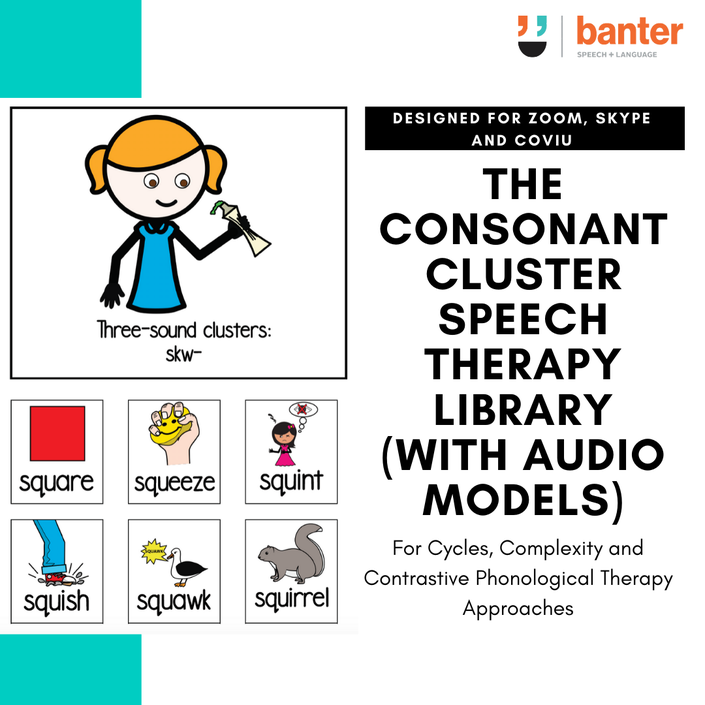
The Consonant Cluster Speech Therapy Library (with audio models)
For Cycles, Complexity and Constrastive Phonological Therapy Approaches. Designed for Zoom, Skype and Coviu.
Watch Video
Deliver evidence-based speech therapy for kids by Telehealth, including by Zoom, Skype and Coviu.
Consonant Cluster Targets ordered from most complex to least complex using sonority differences. More than 120 pages of exercises, including:
- high frequency, functional target words;
- 39 auditory bombardment files for each target cluster in mp3 format for easy download and to email to clients;
- nonword, multisyllabic motor speech drills for each cluster, based on principles of motor learning; and
- near minimal pairs, for adding contrastive treatments.
No preparation needed. Fully scripted, organised and ready for face-to-face and distance/remote/telehealth therapy sessions.
Keen to know more?
Traditional articulation and developmentally-based phonological approaches to therapy work. But they can be slow going! When working with students with significant speech sound problems, we want efficient results - especially if we don't have much face-to-face time to do therapy.
-
Cycles; and
-
Complexity; and
- Contrastive Approaches.
Both approaches seek to bring about permanent, big changes to a student's phonological system and to make students more intelligible. Both approaches rely on choosing good targets that transfer to other speech sounds without having to work on every speech sound in every word position.
-
Three sound clusters (like /spl/, /skw/ and /spr/) are more complex than two sound clusters (like /sl/ and /pr/).
-
So-called “small-sonority-difference clusters” like /sm/, /sn/ and /mj/ (as is “music”) are more complex than “large-sonority-difference clusters” like /tw/, /kw/ and /pl/.
-
True consonant clusters (like /tw/, /pl/, /br/, and /fl/) are more complex than so-called “adjunct clusters” like /sp/, /st/ and /sk/.
-
True consonant clusters’ like /pl/, /sw/ and /fr/ are more complex than affricates like “j” or “ch”.
-
Affricates like “j” or “ch” are more complex than fricatives like /f/ or /s/.
-
Long, “hissy” sounds called “fricatives” (like /f/ and /s/) are more complex than short “stops” like /p/ and /t/.
-
Semi-vowel ‘liquid’ and glide sounds like /l/ and /r/ are more complex than sounds made through your nose, like /n/.
-
are late-acquired developmentally;
-
are complex/marked (e.g. targeting fricatives rather than stops, true clusters rather single sounds, clusters with low sonority differences, rather than high (or negative) sonority differences);
-
the child doesn’t know/cannot yet produce accurately; and
-
the child is not yet stimulable for.
Taking our lead from Cycles, we focus on only 5-6 words per target, per session. Evidence shows that 5-6 exemplars is sufficient to get transfer to untreated words with the same target. It also means you don't waste time (and dosage) explaining lots of new (often weird) vocabulary to students - a big issue for students with working memory and language disorders and other issues.
Further information on how to do the therapy:
The Complexity Approach: https://www.banterspeech.com.au/how-to-treat-speech-sound-disorders-2-the-complexity-approach-more-bang-for-your-buck/
The Cycles Approach: https://www.banterspeech.com.au/how-to-treat-speech-sound-problems-1-the-cycles-approach/
The Contrastive Approach: https://www.banterspeech.com.au/how-to-treat-speech-sound-disorders-3-contrastive-approach-minimal-and-maximal-pairs-with-demo/
Your Instructor

Known to many as Speech Bloke, David is a Certified Practising Speech Pathologist, Lawyer, Author and Father. He is based in Sydney, Australia, where he helps adults and children with communication issues to speak for themselves.
David manages a busy private speech pathology clinic, and a publishing company for speech pathologists in private practice. He is the founder of Banter Speech & Language, and Speechies in Business. He is passionate about ethical practices and consumer rights and regularly guest lectures to speech pathology students and others on legal issues affecting the profession.
David holds a Master of Speech Language Pathology from the University of Sydney, where he was a Dean's Scholar, ranking first in his graduating year. He is admitted as a Solicitor of the Supreme Court of New South Wales and the High Court of Hong Kong, and lived for 8 years in Hong Kong. David is a Certified PESL Instructor for accent modification. He is a Hanen- and LSVT LOUD-certified speech-language pathologist with post-graduate training in the PreLit early literacy preparation program by MultiLit, the Spalding Method for literacy, and Voicecraft for voice issues.
Prior to becoming a speech pathologist, David was a senior lawyer at a US Investment Bank and, before then, worked for global law firms in Hong Kong and Sydney. He knows what it takes to communicate professionally and to compete in a globalised workforce.
